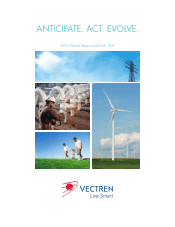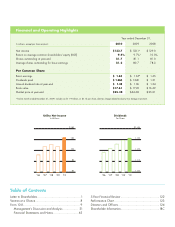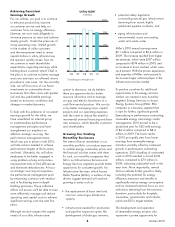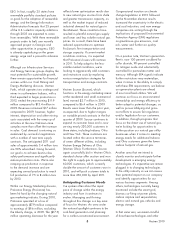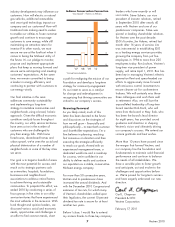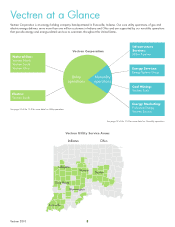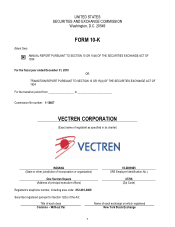Vectren 2010 Annual Report Download - page 7
Download and view the complete annual report
Please find page 7 of the 2010 Vectren annual report below. You can navigate through the pages in the report by either clicking on the pages listed below, or by using the keyword search tool below to find specific information within the annual report.ESG. In fact, roughly 35 states have
renewable portfolio standard policies
or goals for the adoption of renewable
energy, and the Energy Information
Administration forecasts that 25 percent
of the U.S.’s electric capacity additions
through 2035 are expected to come
from renewables. With three renewable
projects under its belt, one recently
approved project in Georgia and
other opportunities in progress, ESG
is already capitalizing on the green
energy surge and is poised to advance
further.
Although our Infrastructure Services
and Energy Services groups display the
most potential for sustainable growth,
there remain opportunities for financial
success within our Coal Mining and
Energy Marketing divisions. Vectren
Fuels, which operates two underground
mines in southwestern Indiana, with a
third expected to begin production in
2012, ended the year earning $11.9
million compared to $13.4 million in
2009. Revenues increased $17 million
compared to 2009; however, higher
interest, depreciation and other mining
costs associated with the ramp up of
activities at the new Oaktown mine
complex more than offset the increase
in sales. Coal demand is returning as
evidenced by successful negotiations
with a number of new term supply
contracts. The anticipated 2011 coal
sales of approximately 5.4 million tons
are 90% subscribed. Going forward,
our goal is to achieve best-in-class
safety performance and significantly
reduce production costs. We’re also
ramping up production in response
to the demand increase and are
expecting annual production to reach
full production of 7.5 to 8 million tons
by 2013.
Within our Energy Marketing division,
ProLiance Energy (ProLiance) has
been hit hard by the changing natural
gas marketing industry. During 2010,
ProLiance operated at a loss of
approximately ($7.9) million compared
to earnings of $9.6 million, excluding
the Liberty charge, in 2009. The ($17.5)
million operating decrease for the year
reflects lower optimization results due
to new natural gas sources from shale
and greater transmission capacity, as
well as the market impact of reduced
industrial demand for natural gas in
the Midwest. These conditions have
resulted in plentiful natural gas supply
and lower and less volatile natural gas
prices. As a result, there have been
reduced opportunities to optimize
ProLiance’s firm transportation and
storage capacity. If current market
conditions continue, it is expected
that ProLiance’s losses will continue
in 2011. To help adapt to the less-
volatile market conditions, we’re
looking to aggressively add customers
and restructure costs by exploring
various renegotiation strategies for
transportation and storage contracts.
Vectren Source (Source), which
functions in the energy marketing arena
at the residential and small commercial
level, earned $3.7 million in 2010,
compared to $6.4 million in 2009.
Results were lower than the prior year,
as expected, due to higher margins
on variable priced contracts in the first
quarter of 2009. Source continues to
expand its customer base and is now
serving nearly 230,000 customers in
three states, including Indiana, Ohio
and New York. These customers are
located within the service territories
of seven different utilities, including
Vectren Energy Delivery of Ohio
(Vectren Ohio). Furthermore, Source
again successfully bid in Vectren Ohio’s
standard choice offer auction and won
the right to supply gas to approximately
60,000 customers, which is nearly
double the amount of customers won in
2010, and will push customer totals to
more than 250,000 by April 2011.
Anticipating Customer Needs
I’ve spoken often about the rapid
pace of change within the energy
industry and how it continues to
evolve. Managing and thriving
throughout this change is a key area
of focus for Vectren. An area under
the national spotlight continues to be
coal-fired generation and planning
for a carbon-constrained environment.
Congressional inaction on climate
change legislation in 2010 followed
by the November election results
increased the uncertainty in the electric
and coal industries, and now energy
companies are sorting through the
implications of proposed Environmental
Protection Agency (EPA) regulations
on greenhouse gas emissions, coal
ash, water and further air quality
measurements.
On a positive note, Vectren’s generation
fleet is now 100-percent scrubbed for
sulfur dioxide, 90-percent controlled
for nitrogen oxide and substantially
controlled for particulate matter and
mercury. Although EPA signals indicate
further restrictions may materialize,
when it comes to the ability to comply
with these EPA requirements, we believe
our generation plants are ahead
of most coal-fired utilities. We will
continue our focus on environmental
stewardship and energy efficiency to
better adapt to potential changes, as
well as pursue lobbying and grass-
root efforts to ensure fair regulation
and/or legislation for our customers.
In addition, through programs that
focus on the direct use of natural gas,
we’re looking for opportunities to
further position our natural gas utility
businesses when it comes to meeting
energy needs for additional Indiana
and Ohio customers given the lower
carbon footprint of natural gas.
Another area that we intend to
closely monitor and anticipate further
development is emerging energy
technologies. It’s imperative we remain
plugged in to changing technologies
in the utility industry so we can assess
their potential impact on our company
and identify opportunities for our
various business segments. Among
others, technologies currently being
monitored include the smart grid,
biomass co-firing at power plants,
carbon capture and sequestration,
electric and natural gas vehicles and
energy storage.
In that same vein, we remain mindful
of how these technologies and other
Vectren 2010
5

